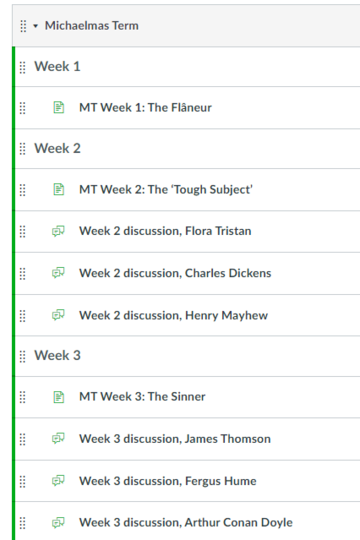- Group size: Small
- Teaching type: Postgraduate
- Division: Humanities
- Subject: English Literature
- Tools: Canvas, Panopto, ORLO, Microsoft Teams
Overview
I used the Canvas template to support my MSt ‘C Course’ in English Literature (‘Literary London, 1820-1920’). There are around eight students in this class. Usually, the course is taught across a term: we have six 1.5-2 hour classes, as well as individual meetings to discuss written work. This year, classes were 1.5 hours and held in-person during Michaelmas term, with a small number of students joining remotely; individual meetings took place on Teams.
Broadly speaking, this course fits into the FIT pathway: Small group - option 1.
Delivery
To enable students to plan ahead, I included links to both the PDF and ORLO versions of the reading list on Canvas; the ORLO version gave students access to all the necessary scanned readings and/or e-chapters.

Figure 1. Course home page in Canvas, with links to materials, readings and a discussion forum
On the ‘General Resources’ tab, students could find a reminder of important dates. Under the headings for each week, there were more details about the set texts, any relevant administrative information, and links to the weekly discussions.

Figure 2. Course structure in ‘module’ layout, presenting weekly material and discussion activities
It was especially important to stick to time this year – to avoid classes overrunning and allow as much space for discussion as possible; therefore I decided to record my usual opening remarks beforehand, using Panopto.
In most weeks, classes were structured around student presentations: presenters were asked to upload their handouts to discussion threads in advance, which was more efficient than emailing them around. After class, everyone was strongly encouraged to post a question/comment under the handout(s).

Figure 3. Discussions in Week 3, showing how students were reminded to upload handouts in advance of class
Strengths and limitations
Uploading handouts and posting comments meant we had an interesting record of the term’s work. I hoped this would create a sense of an ongoing conversation: I.e., that students could have some time to reflect, and to ask questions they hadn’t fully formulated during class time. It also meant that presenters had something concrete to take away – especially important if they were using their presentations to test out ideas for their coursework essays.
I think it is important to suggest at the start of the course that students’ participation online is not only encouraged, but expected. In class, after each presentation or Q&A session, I reminded them that they should take five minutes to post under the handout before we met again.
- Contributed by: Dr Ushashi Dasgupta, Faculty of English